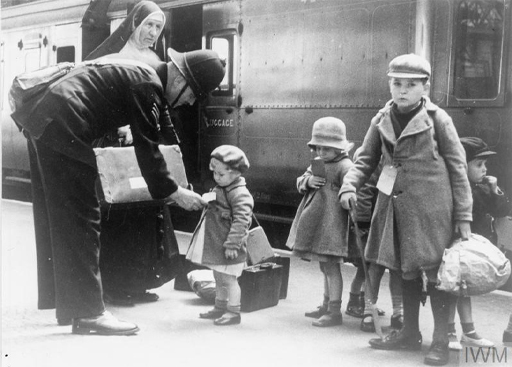1.2 Case study: the impact of war on children
Read the following case study about Sheila, a 6-year-old girl living in Birmingham in 1943 during the Second World War. Sheila’s experience is based on the account of a woman in her 80s, but she vividly recalls the experience of this period of her life.
Case study: Sheila
Sheila is 6, she is an only child and she lives with her mum. Until recently, they lived in a small house known as a back-to-back in the middle of Birmingham. It’s 1942, the fourth year of the Second World War, and there have been many nights of bombing across the country. Normally, the area where Sheila lives is not affected because the bombs are usually targeted on the factories which are further east; however, the planes went off course and dropped a barrage of bombs, one of which hit Sheila’s home and destroyed it.
For the last month, Sheila and her mum have been living with her aunt and her four cousins. Sheila has to sleep on the sofa because the house is so crowded. Each night, for the last week, the siren has gone off at 1 am to warn people that the planes are nearby. The siren means that they all must go to the nearest bomb shelter to wait for the planes to finish their mission.
Everyone is exhausted, food is in short supply and people are hungry. Sheila hates the noise caused by the explosions that happen after the bombs hit a target. However, it’s almost worse waiting for the noise to happen. Sheila feels jumpy and anxious, and she knows she would feel better if she had Snowy, her much loved toy sheep. He had been with her all of her life and he was a dull grey with threadbare patches, and he smelt and felt like home. However, Snowy disappeared when their home was destroyed, and Sheila feels lost and alone without him. She feels that life will never be the same again.
Just as Sheila thinks that things can’t get any worse, two things happen. Firstly, her dad – who is away in France fighting in the war – is reported as missing in action. This means that he may have been taken a prisoner, or he may have been killed, but they don’t know which. The second thing that happens is that Sheila’s mum finds a job in a factory. As money is tight, she decides to take the job, but this means that nobody is available to look after Sheila. So Sheila is evacuated to the countryside, away from the bombing, to live with people who can look after her until it is safe to go back home.
The people who take in the evacuees are strangers; they often live on farms and some use the children as unpaid workers. Life is physically very hard because the children are required to get up early and do chores such as going out in the dark mornings in all weathers to collect eggs or milk cows.
Sheila joins the local school and, at first, she is a source of curiosity to the other children who can’t understand her different accent but try to include her in playtime. However, Sheila is so miserable that she finds it difficult to respond to their attempts to include her, so the other children eventually stop trying to make friends. Sheila becomes withdrawn, finding it hard to speak, eat and sleep. She misses everything about home and feels completely alone in the world.
Sheila returns to her mother after the end of the war. Her life settles down into a routine with her mum, and she happily fits in to her old school again. It turns out that her father has been a prisoner of war, so he too returns home at the end of the war. He is deeply affected by his experiences but takes solace in his family and they go on to have a much-loved brother for Sheila.
Sheila’s adverse childhood experience does not appear to affect her mental health in the long term; however, her experience as a child living through the terror of bombs falling from the sky during the night leaves her with a fear of loud noises, which never goes away. The feeling of loss and separation experienced as an evacuee leaves her with a strong desire to always be with people and have company; her engaging nature means that she has many friends who help to meet that need.
Activity 1 Exploring the mental health impact of being an evacuee in the Second World War
Answer the following questions about the case study.
- What are the reasons why Sheila’s mental health could be affected by her living conditions and external events?
- What events and circumstances appear to help her to recover from her experiences?
Throughout this course, you’ll have the opportunity to record your answers to activities in interactive boxes and save them. No one else will be able to view them. If you’d like to, add your answers to the questions in the box below.
Discussion
The impact of Sheila’s experience could have been very different: she could have experienced long term trauma, which could in turn have resulted in life-long difficulties with her mental health such as anxiety, depression and post-traumatic stress. It is not always obvious why some children are more vulnerable to the effects of adverse experiences than others, although there are several protective factors, which will be discussed further in this course. In Sheila’s case, the absence of mistreatment during her time as an evacuee, the return to a happy routine at home and many positive relationships will undoubtedly have helped her to heal and recover from the experience.

